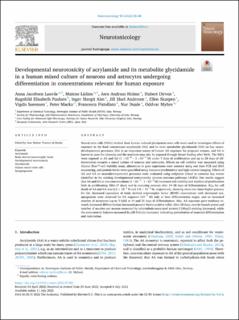| dc.contributor.author | Lauvås, Anna Jacobsen | |
| dc.contributor.author | Lislien, Malene | |
| dc.contributor.author | Holme, Jørn Andreas | |
| dc.contributor.author | Dirven, Hubert | |
| dc.contributor.author | Paulsen, Ragnhild Elisabeth Heimtun | |
| dc.contributor.author | Alm, Inger Margit | |
| dc.contributor.author | Andersen, Jill Mari | |
| dc.contributor.author | Skarpen, Ellen | |
| dc.contributor.author | Sørensen, Vigdis | |
| dc.contributor.author | Macko, Peter | |
| dc.contributor.author | Pistollato, Francesca | |
| dc.contributor.author | Duale, Nur | |
| dc.contributor.author | Myhre, Oddvar | |
| dc.date.accessioned | 2022-10-10T06:24:35Z | |
| dc.date.available | 2022-10-10T06:24:35Z | |
| dc.date.created | 2022-08-22T09:47:16Z | |
| dc.date.issued | 2022 | |
| dc.identifier.citation | Neurotoxicology. 2022, 92 33-48. | |
| dc.identifier.issn | 0161-813X | |
| dc.identifier.uri | https://hdl.handle.net/11250/3024867 | |
| dc.description.abstract | Neural stem cells (NSCs) derived from human induced pluripotent stem cells were used to investigate effects of exposure to the food contaminant acrylamide (AA) and its main metabolite glycidamide (GA) on key neurodevelopmental processes. Diet is an important source of human AA exposure for pregnant women, and AA is known to pass the placenta and the newborn may also be exposed through breast feeding after birth. The NSCs were exposed to AA and GA (1 ×10-8 - 3 ×10-3 M) under 7 days of proliferation and up to 28 days of differentiation towards a mixed culture of neurons and astrocytes. Effects on cell viability was measured using Alamar Blue™ cell viability assay, alterations in gene expression were assessed using real time PCR and RNA sequencing, and protein levels were quantified using immunocytochemistry and high content imaging. Effects of AA and GA on neurodevelopmental processes were evaluated using endpoints linked to common key events identified in the existing developmental neurotoxicity adverse outcome pathways (AOPs). Our results suggest that AA and GA at low concentrations (1 ×10-7 - 1 ×10-8 M) increased cell viability and markers of proliferation both in proliferating NSCs (7 days) and in maturing neurons after 14-28 days of differentiation. IC50 for cell death of AA and GA was 5.2 × 10-3 M and 5.8 × 10-4 M, respectively, showing about ten times higher potency for GA. Increased expression of brain derived neurotrophic factor (BDNF) concomitant with decreased synaptogenesis were observed for GA exposure (10-7 M) only at later differentiation stages, and an increased number of astrocytes (up to 3-fold) at 14 and 21 days of differentiation. Also, AA exposure gave tendency towards decreased differentiation (increased percent Nestin positive cells). After 28 days, neurite branch points and number of neurites per neuron measured by microtubule-associated protein 2 (Map2) staining decreased, while the same neurite features measured by βIII-Tubulin increased, indicating perturbation of neuronal differentiation and maturation. | |
| dc.description.abstract | Developmental neurotoxicity of acrylamide and its metabolite glycidamide in a human mixed culture of neurons and astrocytes undergoing differentiation in concentrations relevant for human exposure | |
| dc.language.iso | eng | |
| dc.title | Developmental neurotoxicity of acrylamide and its metabolite glycidamide in a human mixed culture of neurons and astrocytes undergoing differentiation in concentrations relevant for human exposure | |
| dc.title.alternative | Developmental neurotoxicity of acrylamide and its metabolite glycidamide in a human mixed culture of neurons and astrocytes undergoing differentiation in concentrations relevant for human exposure | |
| dc.type | Peer reviewed | |
| dc.type | Journal article | |
| dc.description.version | publishedVersion | |
| dc.source.pagenumber | 33-48 | |
| dc.source.volume | 92 | |
| dc.source.journal | Neurotoxicology | |
| dc.identifier.doi | 10.1016/j.neuro.2022.07.001 | |
| dc.identifier.cristin | 2044814 | |
| cristin.ispublished | true | |
| cristin.fulltext | original | |
| cristin.qualitycode | 1 | |
